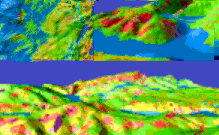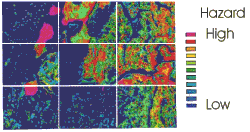Proactive disclosure
Print version   |  | 
Natural Resources Canada > Earth Sciences Sector > Priorities > Strong and safe communities > Spatial data analysis
Spatial data analysis Prediction models in spatial data analysis for landslide hazard mapping

| Brief history of spatial prediction modeling at the GSC |
1972: Agterberg, F.P. et al., Prediction models for locating undiscovered copper deposits.
1977-1980: Chung C.F., Development of SIMSAG (interactive graphic system), CDC 6400 + tektronix 4014 terminal maximum number of pixels: 100 x 100
1990: Agterberg, F.P. and Bonham-Carter G.F. (eds.), GSC paper 89-9, Statistical Applications in the Earth Sciences
1992 - 1997: Spatial Data Analysis Laboratory. Development of spatial data integration system SGI, Windows NT/95/98/3.1 maximum number of pixels (in practice) 4000 x 4000
| Basic idea: the favorability function |
At each pixel, p:
ƒ(Tp: given m causal factors vk(p)=1 . . . m)
Tp: (p will be affected by a future landslide of type D)
The "sureness" that the proposition Tp is true given the m causal factors (vk(p)=1 . . . m), is being measured.
By "sureness" we mean: probability, certainty, belief, plausibility, possibility ...
Mathematical frameworks
Three mathematical frameworks used for the models are:
- Probability theory
- Joint Conditional Probability Function
The measurement of the "sureness" that the proposition Tp:(p will be affected by a future landslide) is true, given the m causal factors (vk(p)=1 . . . m) is assumed to be the joint conditional probability function
f(Fp|c1,c2,...,cm) = Prob(Fp|c1,c2,...,cm)
representing hazard at p with pixel information on
p:(c1, c2,...,cm)
F: the unknown area to be affected by future landslides
Θ: The set of pixels whose pixel values are (c1, c2,...,cm)
The prior probability representing hazard at p with no pixel information at p is:
(size of (F∩A) /size of A)
where A represents the whole study area.
Pixel p is hazardous:
Prob{Fp|c1,c2,...,cm} >> Prob{Fp}
Pixel p is not hazardous:
Prob{Fp|c1,c2,...,cm} << Prob{Fp}
- Likelihood ratio function
The likelihood ratio at p is defined as:
λ =Prob{c1,c2,...,cm|Fp}/
Prob{c1,c2,...,cm|notFp}
=1-Prob{Fp} / Prob{Fp}
* Prob{Fp|c1,c2,...,cm}/
1- Prob{Fp|c1,c2,...,cm}
- Monotone functions of the likelihood ratio function
- Weights of evidence function
model by Peirce (1878) and Good (1950,1960, and 1976) (also see Spiegelhalter, 1986; Agterber et al, 1990; Bonham_Carter et al. 1989).
WoE{Fp|c1,c2,...,cm} = logeλ
- Certainty factor function
model by Shortliffe and Buchanan (1975:MYCIN), Heckerman (1986), Pearl(1988) and Chung and Fabbri (1990)
CF{Fp|c1,c2,...,cm} = λ -1 / λ -1
- Comparison of the weights of evidence and certainty factor functions at two pixels:
Let (c1, c2,...,cm) be the m pixel values of p
Let (c1, c2,...,cm) be the m pixel values of q
If Prob{Fp} <=Prob{Fq} Then λ(p)<=λ(p)
Relative "hazardness" of the pixels is the same regardless of which measurements are used for the study.
- Dempster-Shafer evidential theory
- Belief and plausibility functions
- Zadeh's fuzzy set theory
Sp: "p has been affected by a past landslide of a given type
Prob{Sp|c1,c2,...,cm}= size of S
Θ / size of Θ
Prob{Sp}=size of S / size of A
where S represents the areas affected by past landslides
Prob(Fp|c1,c2,...,cm) = Prob(Sp|c1,c2,...,cm)
λD = Prob{c1,c2,...,cm|Sp} /
Prob{c1,c2,...,cm|notSp}
=1-Prob{Sp} / Prob{Sp} *
Prob{Sp|c1,c2,...,cm} /
1- Prob{Sp|c1,c2,...,cm}
CFD{Fp|c1,c2,...,cm}
=λ -1 / λ -1
WoED{Fp|c1,c2,...,cm} = logeλ
The order is preserved. The estimators are simple to compute, and do not
require any mathematical assumptions. They fail badly as predictors of the
occurrence of future landslides. They should be computed as benchmarks of
the performance of spatial data as causal factors of landslides.
Prob{Fp|c1,c2,...,cm}=
Prob{Fp}Prob{c1,c2,...,cm|Fp}
/ Prob{c1,c2,...,cm}
Conditional independence assumption given Fp
Prob{c1,c2,...,cm|Fp}
=Prob{c1|Fp}Prob{c2|Fp}
...Prob{cm|Fp}
Prob{Fp|c1,c2,...,cm}
=(Prob{c1|Fp}...Prob{cm|Fp}
/ Prob{Fp|c1,c2,...,cm})
Prob{F}(Prob{Fp|c1} / Prob{F})...
(Prob{Fp|cm} / Prob{F})
Prob{c1,c2,...,cm}= size of Θ / size of A,
Prob{ck}= size of Akck / size of A,
Prob{Fp|ck} = size of F ∩ size of Akck / size of A,
Prob{Sp|ck} =size ofS∩ size of Akck / size of A,
Prob{Sp} =size ofS / size of A
Bayesian estimate at each pixel p:
Prob{Fp|c1,c2,...,cm}
=(Prob{c1|Sp}...Prob{cm|Sp}
/ Prob{Sp|c1,c2,...,cm})
Prob{S}(Prob{Sp|c1} / Prob{Sp})...
(Prob{Sp|cm} / Prob{Sp})
The likelihood ratio becomes:
λ = λ1 ... λm
λ1 =Prob{c1|Fp} / Prob{c1|notFp}
=Prob{Fp|c1}(1-Prob{Fp}
/ Prob{Fp}(1-Prob{Fp|c1}
λ' = λ'1 ... λ'm
λ'k =Prob{ck|Sp} / Prob{ck|notSp}
=Prob{Sp|ck}(1-Prob{Sp}
/ Prob{Sp}(1-Prob{Sp|ck}
CF2={Fp|c1,c2,...,cm}=(λ' - 1) / (λ' + 1)
WOE2={Fp|c1,c2,...,cm}=logeλ'
The advantage of this estimator is that it depends only on bivariate
conditional probabilities of the occurrences of past landslides given pixel
values at each layer separately. However, the price of this advantage is
adherance to the conditional independence assumption.
- Time robustness:
We divide the occurrences into two time periods "past" and "future".
Construct the prediction model based on the "past" occurrences, and then validate the results
with respect to "future" occurrences.
We select a year so that approximately half the events occur during or before it.
We pretend that year is the current one and use these events in the model to see how
well the rest are predicted.
- Space robustness:
Divide the study areas into several non-overlapping subareas.
To construct a prediction map for each subarea, use the data from outside of the subarea ONLY.

Figure 1: This is a mosaic of nine prediction maps based on nine divisions of the study area, Rio
Chinchina, Colombia using the Algebraic sum operation of the Fuzzy set
framework. To construct a prediction map for each section, use the data from the
other eight sections. Then mosaic the prediction maps (one from each subarea).
Compare the mosaic-prediction map against past landslide occurrences.
- Random:
Divide the occurrences into two groups randomly: group 1 and group 2.
Construct the prediction map based on group 1 ONLY, then validate the results with respect
to group 2 occurrences. Repeat the procedure in reverse order.
- Combination:
Sometimes using a combination the random, space robustness and time robustness validation procedures is useful.
|
